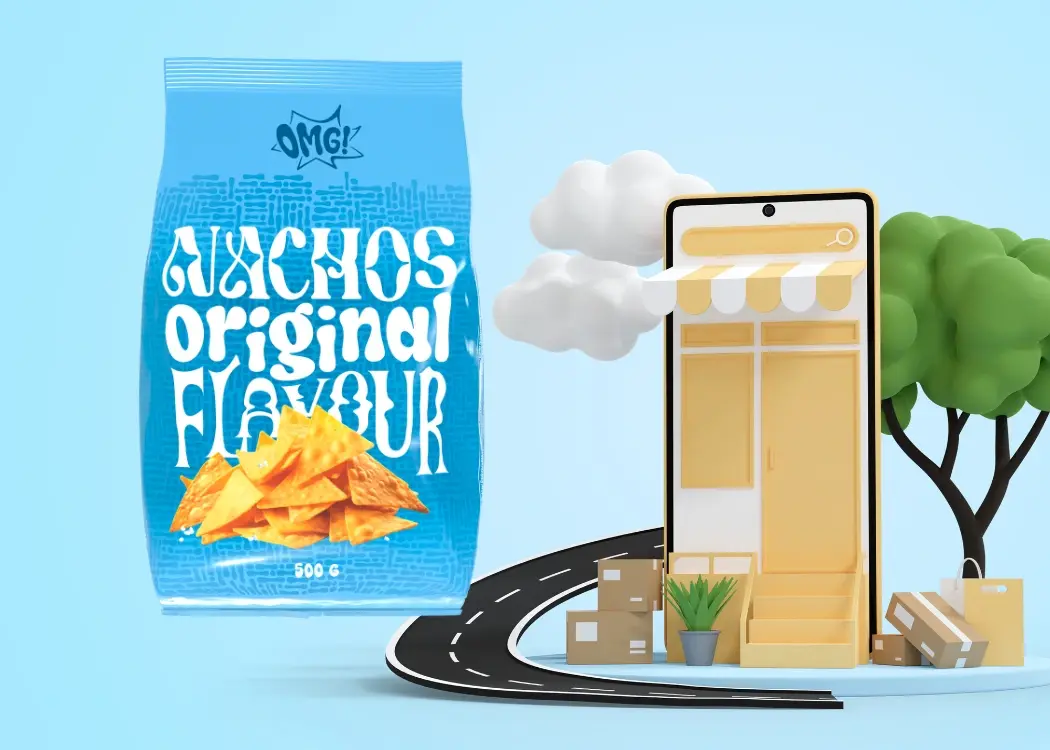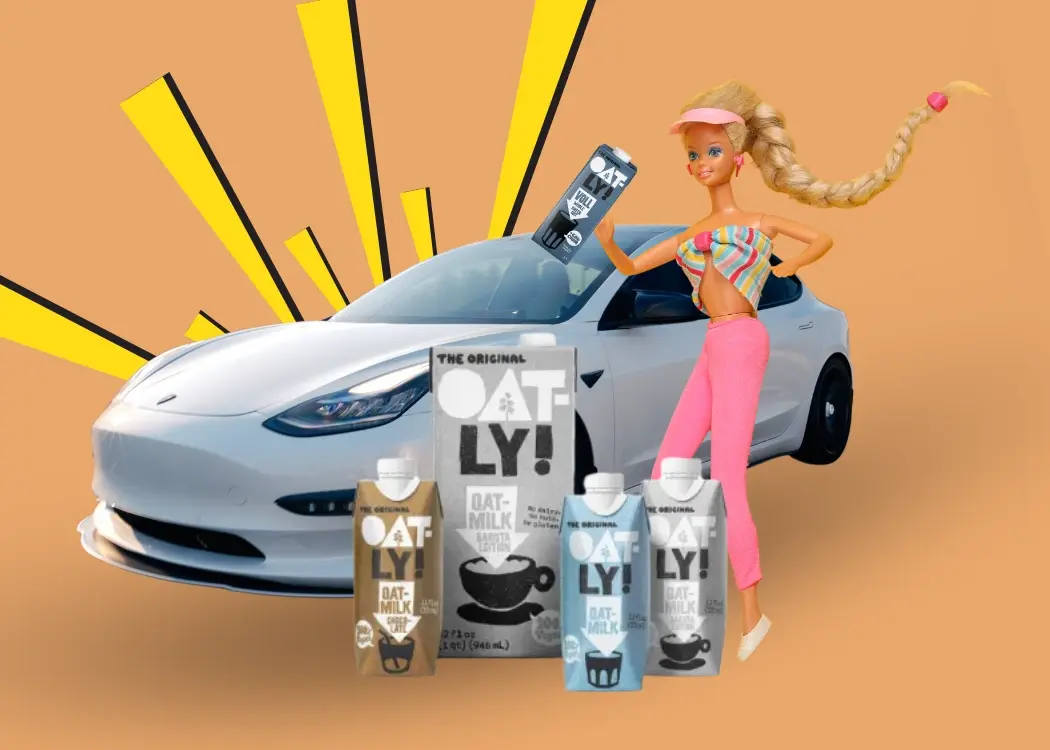What ties Barbie, Oatly & Tesla together? Brilliant packaging
When you think of Barbie, you might picture hot pink plastic. Oatly? Probably that cheeky, handwritten font on a beige carton. And Tesla—sleek,...
5 min read
 Ekaterina Skalatskaia
:
September 29, 2025 at 10:15 AM
Ekaterina Skalatskaia
:
September 29, 2025 at 10:15 AM

Creating the perfect e-commerce packaging design and hero images has never been more important. As online shopping continues to dominate retail, brands must ensure their product visuals are optimized for digital shelves. In this article, we'll explore how to create e-commerce packs and hero images that not only look great but also meet retailer standards. We’ll also show how Cway® software helps teams manage, approve, and deliver assets faster and with fewer errors.
In the digital age, your product packaging is often your only chance to make a first impression. Online, customers can’t touch or feel the product. Your images, text, and design must do all the work of communicating value, quality, and trust.
The digital shelf refers to how your product appears on online platforms like Amazon, Walmart, and Instacart. Unlike physical shelves, digital shelves are:
Visual-first
Competitive (side-by-side comparisons)
Algorithm-driven (affecting visibility and conversions)
In this context, hero images become critical. They are the first product photo shoppers see—often the deciding factor in whether they click or scroll past.
In online retail, your hero image is the first impression customers get of your product. It plays a decisive role in whether someone clicks “add to cart” or keeps scrolling. Unlike lifestyle or secondary images, the hero image is the main product shot shown on search result pages, product detail pages, and retailer listings. Getting it right is essential for driving conversions.
A strong hero image should be:
Clean and Clear – Avoid background clutter, props, or shadows. The focus should be solely on the product.
True to Packaging – The image must accurately reflect what the customer will receive. A misleading photo can damage trust and increase returns.
Optimized for All Devices – Images should scale well on both desktop and mobile. Since most e-commerce traffic comes from mobile, labels and text must remain legible even at smaller sizes.
Retailer-Compliant – Each retailer (Amazon, Walmart, Tesco, Carrefour, etc.) has specific size, background, and formatting requirements. A compliant hero image ensures smooth product listing approval and better visibility.
High-Resolution and Professional – Sharpness, lighting, and contrast make the difference between an image that looks amateurish and one that drives sales.

When brands — especially brand managers, packaging designers, and compliance teams — work with e-commerce pack shots (hero images, thumbnails, and secondary visuals), they face a set of recurring challenges. Here’s a structured breakdown:
Different retailer requirements: Amazon, Walmart, Carrefour, Tesco, and other platforms all have slightly different image specifications (size, background, DPI, file format).
Difficulty in maintaining a single “source of truth”: Without centralized digital asset management, different versions of the same product image may circulate, leading to outdated or inconsistent listings.
Impact: Brand image fragmentation and consumer confusion.
Regulatory compliance: Pack shots must reflect real packaging, including mandatory information (nutrition labels, claims, allergens, recycling icons, etc.). Any discrepancy risks fines, de-listing, or customer complaints.
Misleading visuals: Overly “beautified” or stylized pack shots may result in consumer disappointment when the delivered product looks different.
Approval workflows: Multiple stakeholders need to review images (design, legal, marketing, regulatory), which slows down time-to-market.
Mobile-first challenge: Over 70% of e-commerce browsing happens on mobile. Logos, claims, and key text must remain readable even when thumbnails are tiny.
Low-quality uploads: If high-resolution master files aren’t used, images can appear pixelated, poorly lit, or distorted on product detail pages.
Localization: Ensuring translated packs and region-specific compliance info are visible and correct.
Siloed processes: Designers create, marketers upload, and compliance approves — often using disconnected systems. This leads to version control problems.
Manual resizing & reformatting: Without automation, teams waste time adapting the same pack shot for different retailer templates.
Feedback loops: Back-and-forth revisions can delay product launches and campaigns.
Inconsistent brand presentation: Poorly executed hero images undermine brand equity.
Lost sales opportunities: If the hero image isn’t clear or attractive, shoppers may skip the listing, reducing conversions.
Returns & negative reviews: When the online product doesn’t match the physical packaging, trust is eroded.
Without centralized systems, it’s easy for errors to creep in. Wrong label. Outdated dieline. Unapproved changes. All of which lead to delays or even retail rejections.
Working with e-commerce pack shots and packaging assets doesn’t have to be messy. Cway® software is an all-in-one platform that empowers brand managers, packaging designers, and compliance teams to streamline their workflows — from creation to approval to distribution.
Here’s how Cway directly addresses the key challenges brands face:
Instead of juggling multiple folders, email attachments, or shared drives, Cway® offers a single source of truth for all packaging files — from dielines and hero images to final approved artworks. This eliminates the risk of duplicate or outdated assets circulating across teams or retailers.
Learn more: digital asset lifecycle management guide.
Packaging projects often stall because approvals are stuck in inboxes. With Cway®, you can set up automated workflows that notify the right stakeholders at each stage — designers, brand managers, compliance officers — ensuring no bottlenecks and faster speed to market.
Related reading: streamline your artwork approval process.
Keeping track of revisions is one of the hardest parts of packaging and e-commerce imagery. Cway® automatically records every change, allowing teams to compare versions, roll back if needed, and eliminate confusion about which file is final. This ensures everyone — from marketing to legal — is aligned.
Learn more: top 7 artwork management solutions for packaging projects in 2025.
Each retailer has different technical requirements for pack shots (dimensions, file format, backgrounds). Cway® helps brands validate and standardize assets against retailer specifications before they’re submitted, reducing costly rejections and delays.
Learn more: what is an artwork management system?
Instead of endless email chains or scattered comments in PDFs, teams can collaborate directly within the platform. Designers upload, marketers review, compliance approves — all in real time. This reduces miscommunication, speeds up decision-making, and creates full transparency across the asset lifecycle.
Learn more: artwork lifecycle management (ALM): a guide for packaging teams
With Cway®, brands don’t just manage pack shots — they master the entire packaging artwork lifecycle, ensuring every product image is accurate, compliant, and ready to convert in the e-commerce space.
Packaging design for e-commerce is about more than just looking good — it’s about ensuring your product stands out, meets retailer requirements, and builds consumer trust. Here are key tips to elevate your packaging design process:
Every retailer (Amazon, Walmart, Carrefour, Tesco, etc.) has unique requirements for image size, file format, background color, and even how much space the product should occupy in the frame. Missing these details can result in delays, rejections, or poor visibility on their platform.
Tip: Create and maintain a master checklist of retailer specs so your design and production teams don’t have to search for requirements each time.
Since more than 70% of online shoppers browse on mobile, your packaging design and hero images must remain clear and legible at thumbnail size. If the logo, flavor, or claim can’t be read on a smartphone screen, you risk losing conversions.
Tip: Test your pack shots on mobile mockups to check whether brand name, product type, and key benefits are still visible.
Low-quality images don’t just look unprofessional — they damage brand trust and can discourage purchases. A blurry logo or pixelated product detail suggests a lack of attention to quality.
Tip: Always work with print-quality master files (300 DPI) and export optimized versions for web, ensuring crispness without bloated file sizes.
Proofing can be one of the biggest bottlenecks in packaging projects. If feedback is scattered across emails, PDFs, and chat threads, mistakes slip through and launch timelines stretch out.
Tip: Use a dedicated artwork management tool like Cway® software to centralize reviews, set automated approval steps, and keep a record of changes. This not only reduces errors but also makes audits and compliance checks easier.
Successful e-commerce packaging isn’t just a design job — it requires input from marketing, compliance, legal, and supply chain teams. Getting the right stakeholders involved at the right stages prevents costly reworks late in the process.
Tip: Build a cross-functional workflow where stakeholders can review and comment in real time. This fosters alignment and avoids last-minute surprises before product launch.
Perfecting your e-commerce packaging design and hero images is no longer optional—it’s essential for digital shelf success. With the right systems in place, your brand can launch faster, reduce errors, and outshine the competition.
Cway® software makes it all possible by centralizing your packaging workflows, automating approvals, and ensuring every asset is retail-ready.
Stay ahead. Stay compliant. Get to market faster with Cway®.
Cway® automatically tracks versions, approvals, and updates — giving you full visibility at every step of the packaging lifecycle.

When you think of Barbie, you might picture hot pink plastic. Oatly? Probably that cheeky, handwritten font on a beige carton. And Tesla—sleek,...
For most of history, packaging was purely practical — a protective shell, a label, a way to get a product from factory to shelf. But at some point,...

Brand consistency is what makes a product instantly recognizable and trustworthy. From packaging design to marketing materials, every detail shapes...